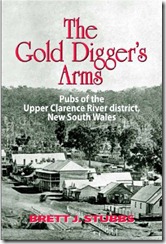
The Gold Digger’s Arms
The Gold Digger’s Arms:
Pubs of the Upper Clarence River District, New South Wales
By Brett J. Stubbs
 In this book Brett J. Stubbs, an environmental historian and Australia’s leading historian of beer and breweries, turns his hand to local history, albeit a local history that reflects his areas of expertise. Typical of most local histories, this one contains much local detail, but amid the many dates, persons, and places emerges a compelling and fascinating story of the early settlement of the Australian bush, mining booms and busts, the more settled logging and dairying pioneers, the development of transport, and the state’s licensing of drinking establishments.
In this book Brett J. Stubbs, an environmental historian and Australia’s leading historian of beer and breweries, turns his hand to local history, albeit a local history that reflects his areas of expertise. Typical of most local histories, this one contains much local detail, but amid the many dates, persons, and places emerges a compelling and fascinating story of the early settlement of the Australian bush, mining booms and busts, the more settled logging and dairying pioneers, the development of transport, and the state’s licensing of drinking establishments.
The Upper Clarence River district sits in the far north of New South Wales, separated from Queensland by the Great Dividing Range. The history of the area’s pubs reflects the history of its settlement. Sheep and cattle grazing began in the 1840s, and the early pubs developed from wayside inns that catered for travellers on the main roads. The discovery of gold in the late 1850s and later silver and tin brought the inevitable rush of fortune seekers.
A bustling settlement of several hundred miners required a pub or two to provide “accommodation, meals, alcoholic beverages, entertainment and amusement, meeting space, and stabling and feed for the horses.” For example, in 1879 the settlement at Boorook, with a population of “about 300,” had three pubs and one wine shop. Several pubs became regional social centres, as illustrated by the Wylie Creek Hotel at Wylie Creek. Its proprietor organised a horse race for St. Patrick’s Day, held a “free ball and supper” on New Year’s Eve, had a theatre that could seat 300, and faced prosecution for allowing illegal games.
While several pubs were of flimsy construction, others were substantial establishments, as indicated by the advertisement for the sale of one: “built of sawn timber with a shingled roof, and consists of two sitting rooms, two large dining rooms, seven spacious bedrooms (well ventilated), bar parlor, stables, outhouses; also large store and orchard.”
Many pubs sprung up only to fold in a year or two as the miners left to try their luck elsewhere; when the Fairfield mines near Drake became unproductive in 1889, three of its five pubs were forced to close. According to Stubbs’ count, 50 pubs were established during this period; only six remain.
Mining busts were not the only reason for the decline in the number of pubs. In 1881 New South Wales had one pub for every 228 persons, a situation that the temperance movement considered intolerable. As stated by one local, “I had seen the ill-effects caused by bush pubs in many places.” The movement’s agitation led to licensing reform, including a law enacted in 1905 that strengthened local option, which froze the number of pubs and required many to close, so that by the mid-1960s the state had one pub for every 2,200 persons. These changes coincided with a change in the settlement pattern of the Upper Clarence River district, as dairy-farming families moved into the area.
One of the attractive features of Stubbs’ book is the many photographs of the old pubs, including photographs of those which have survived. One minor quibble: I would have liked him to devote more space to summary and conclusion as a guide to readers working their way through the local detail. On the whole, however, the book is well written and researched and could appeal to readers even though they might have no interest in the Upper Clarence River.
The Gold Digger’s Arms: Pubs of the Upper Clarence River District, New South Wales Brett J. Stubbs, (Tankard Books: East Lismore NSW, 2009), viii + 120 pp., 53 figures, including maps and illustrations.



